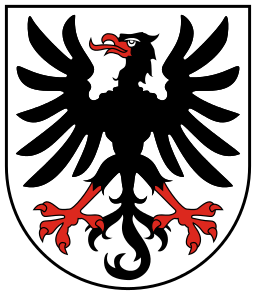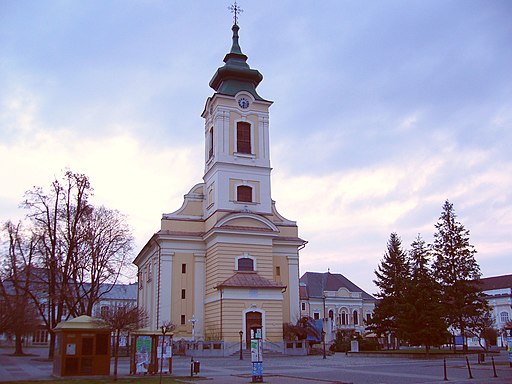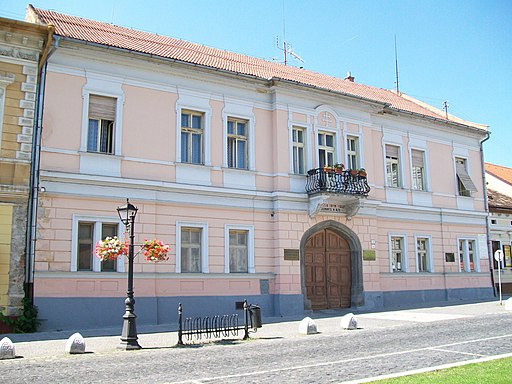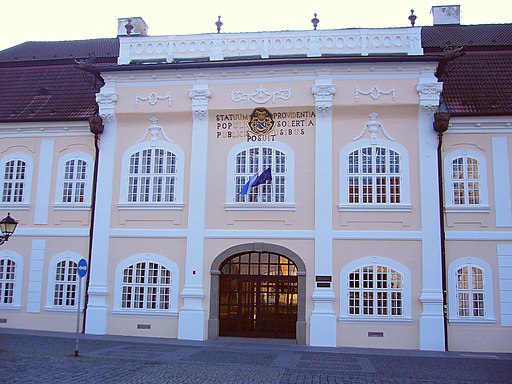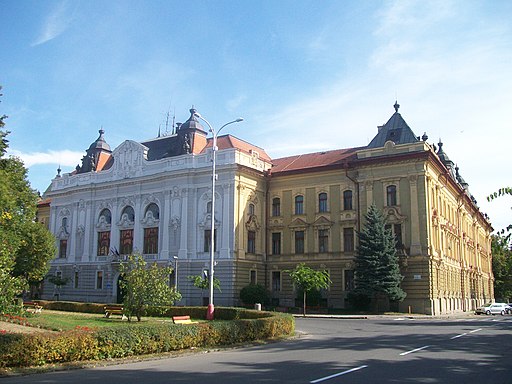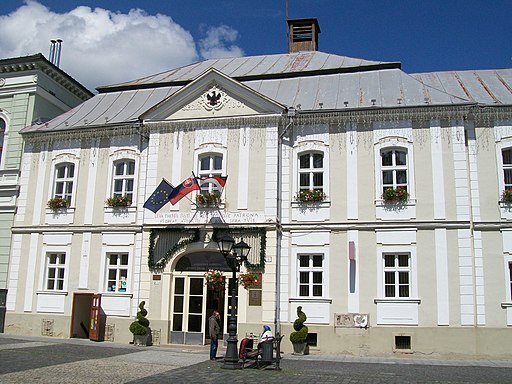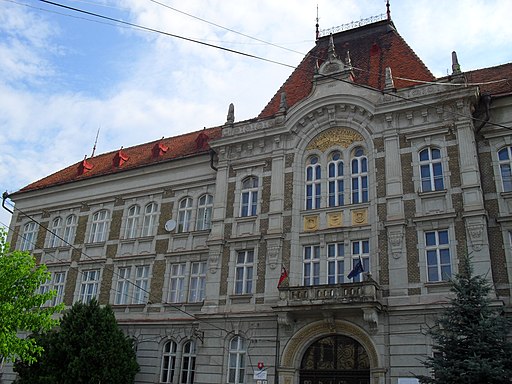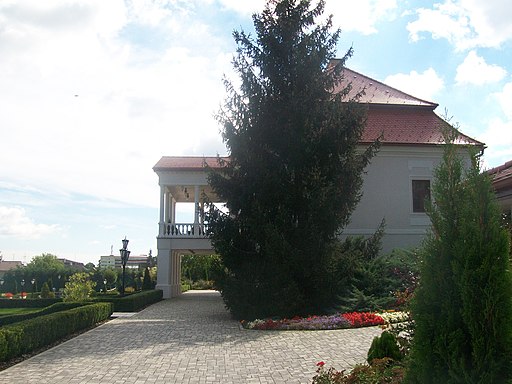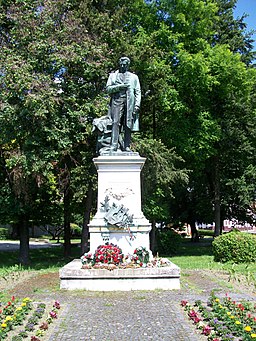Rimaszombat
Rimavská Sobota
Rimaszombat
Historical Hungarian county:
Gömör-Kishont
District:
Banskobystrický kraj
GPS coordinates:
48.383447, 20.017599
Population
Population in 1910
| Total |
6912 |
| Hungarian |
90% |
| German |
1% |
| Slovak |
7% |
The town is located at the foot of the Rátkó Mountains on the banks of the Rima River. It got its name from the river and from its fairs held on Saturdays. The predominantly Hungarian town was the seat of Gömör-Kishont County until 1920, when it was attached from Hungary to the newly created Czechoslovakia. Several famous Hungarians were associated with the town, which proudly preserves the memory of Petőfi Sándor, the great poet of the Hungarian Revolution in 1848, who visited Rimaszombat in 1845. The sculptor Ferenczy István rests in its Calvinist church, and several famous people attended its grammar school, for example the writer Mikszáth Kálmán and the sculptor Izsó Miklós. The statue of Petőfi Sándor, based on the plaster model created by Izsó Miklós, was erected in the town in 2004.
Check out other towns in Upper Hungary (Slovakia) as well!
895
Arrival of the Hungarians
Little more...
895
The alliance of the seven Hungarian tribes took possession of the then largely uninhabited Carpathian Basin. Until then, the sparse Slavic population of the north-western Carpathians had lived under Moravian rule for a few decades after the collapse of the Avar Khaganate in the early 9th century.
1000
Foundation of the Hungarian Kingdom
Little more...
1000
The Kingdom of Hungary was established with the coronation of King Stephen I. He converted the Hungarians to Christianity and created two archdioceses (Esztergom and Kalocsa) and ten dioceses. He divided Hungary into counties led by ispáns, who were appointed by the king.
1241-1242
Mongol Invasion
Little more...
1241-1242
The hordes of the Mongol Empire invaded Hungary and almost completely destroyed it. One third to one half of the population was destroyed. The Mongols also suffered heavy losses in the battle of Muhi and they could not hunt down the king. After their withdrawal, King Béla IV reorganized Hungary. He allowed the feudal lords to build stone castles because they were able to successfully resist the nomadic Mongols. The vast majority of stone castles were built after this. The king called in German, Vlach (Romanian) and Slavic settlers to replace the destroyed population.
1268
First mentioned. It was the center of the County of Rima, the property of the Archbishopric of Kalocsa.
1301
The extinction of the House of Árpád
Little more...
1301
The House of Árpád, the first Hungarian royal dynasty, died out with the death of King Andrew III. Hungary was ruled by oligarchs, the most powerful of whom was Csák Máté, whose main ally was the Aba family. King Charles I (1308-1342), supported by the Pope, eventually emerged as the most prominent of the contenders for the Hungarian throne. But it took decades to break the power of the oligarchs.
1335
King Charles I of Hungary granted the town privileges.
15th century
The town was surrounded by wall and a small castle was constructed.
1440
After the death of King Albert of the House of Habsburg, the Estates of Hungary elected the Polish Ulászló to the throne. Elisabeth, the widow queen, in order to secure the throne for László, her baby boy, called in the Czech Hussite mercenary leader Jan Jiskra. She gave him the title "Captain of the Mining Towns and Kassa", and gave him the castle of Zólyom.
1440-1441
The Czech Hussites soon occupied much of northern Hungary. They reinforced the castles and turned them into bandit lairs. They were pillaging everywhere and large areas became uninhabited. They wiped out the local German and Hungarian population, who were replaced by Czech and other Slavic settlers. The Czech Hussite devastation largely contributed to the Slavicisation of northern Hungary (now Slovakia).
1441
Czech Hussites occupied the town.
1459
King Matthias Corvinus took back the town from the Hussites.
1462
The army of King Matthias of Hungary, under the command of Szapolyai Imre and István defeated the Hussites. Soon their leader, Jiskra also surrendered and handed over his castles to the king.
1509
Rimaszombat was destroyed by a great fire.
1526
Battle of Mohács and the splitting of Hungary into two parts
Little more...
1526
Sultan Suleiman I launched a war against Vienna, instigated by the French. Ferdinand I, Duke of Austria, was the brother-in-law of King Louis II of Hungary. The army of the Ottoman Empire defeated the much smaller Hungarian army at Mohács, and King Louis II died in the battle. A group of the barons elected Ferdinand I of the House of Habsburg to the throne, who promised to defend Hungary from the Turks. He was the younger brother of the most powerful European monarch Emperor Charles V. But the nobility chose the most powerful Hungarian baron, Szapolyai János, who was also crowned as King John I. The country was split in two and a decades-long struggle for power began.
1541
The Turkish occupation of the capital, Buda, and the division of Hungary into three parts
Little more...
1541
The Turks conquered Buda, the capital of Hungary, after the death of King John I. The central part of the country was under Turkish rule for 150 years. The western and northern parts (including present-day Slovakia) formed the Kingdom of Hungary ruled by the Habsburg emperors. The eastern parts (now mainly under Romanian rule) were ruled by the successors of King John I of Hungary. In 1571, John II (John Sigismund), the son of King John I of Hungary, renounced the title of King of Hungary in favor of King Maximilian of the House of Habsburg, and henceforth held the title of Prince. This formally created the Principality of Transylvania, which was the eastern half of Hungary not ruled by the Habsburgs and was also a vassal of the Ottoman Empire. John II died in 1571, after which the three nations of Transylvania (the Hungarian nobility, the Székelys and the Saxons) elected the prince.
1619
The campaign of Prince Bethlen Gábor of Transylvania in the Thirty Years' War
Little more...
1619
At the beginning of the Thirty Years' War (1618-1648), Prince Bethlen Gábor of Transylvania went to war against the Habsburg emperor as an ally of the rebelling Czech-Moravian-Austrian estates. The whole Kingdom of Hungary joined him, only the Austrian defenders of Pozsony had to be put to the sword. With his allies, he laid siege to Vienna. However, he was forced to abandon the siege because the Habsburg-loyal Hungarian aristocrat Homonnai Drugeth György attacked his heartland with Polish mercenaries. On 25 August 1620, the Diet of Besztercebánya elected Bethlen Gábor King of Hungary as vassal of the Turks. He continued to fight after the defeat of the Czechs at White Mountain on 8 November 1620, but without real chance to achieve decisive victory, he decided to come to an agreement with Emperor Ferdinand II.
September 1619
The town surrendered to Prince Bethlen Gábor of Transylvania.
from June, 26 to July 2, 1621
Bethlen Gábor, Prince of Transylvania was in Rimaszombat.
31 December 1621
Peace of Nikolsburg
Little more...
31 December 1621
Prince Bethlen Gábor of Transylvania made peace with Emperor Ferdinand II. Their agreement secured the constitutional rights of the Estates of Hungary, and later it was supplemented with the freedom of religion. Bethlen renounced the title of King of Hungary in exchange for seven counties of the Upper Tisza region (Szabolcs, Szatmár, Bereg, Ugocsa, Zemplén, Borsod, Abaúj) for the rest of his life, other estates in Hungary as his private property and the imperial title of Duke of Oppeln and Ratibor (Opole and Racibórz), one of the Duchies of Silesia. Prince Bethlen went to war against the Habsburgs in 1623 and 1626, but was unable to negotiate more favourable terms.
1644-1645
The campaign of Prince Rákóczi György I of Transylvania in the Thirty Years' War
Little more...
1644-1645
Prince Rákóczi György I of Transylvania allied with the Swedes and the French in the Thirty Years' War and went to war against the Habsburg Emperor Ferdinand III. On 18 July 1645 his army joined forces with Torstenson's Swedish army under Brno (Moravia). The excellent artillery of Transylvania opened fire on the city walls. However, Rákóczi had to give up the siege, having been informed that the Turks were planning a punitive campaign against Transylvania, because he went to war against the Sultan's prohibition.
June 1645
In Rimaszombat the Turkish emissary ordered Prince Rákóczi György I of Transylvania to withdraw, but Rákóczi continued to push forward with his army instead, and joined the Swedish army in Moravia against the Habsburgs.
16 December 1645
Peace of Linz
Little more...
16 December 1645
Prince Rákóczi György I of Transylvania made peace with Emperor Ferdinand III. It secured the freedom of religion for the Protestants and extended it also to the serfs. Rákóczi received the same seven Hungarian counties that Prince Bethlen Gábor had also held (Abauj, Zemplén, Borsod, Bereg, Ugocsa, Szabolcs, Szatmár) until his death, and the counties of Szabolcs and Szatmár were also to be inherited by his sons. The Rákóczi family also received several new estates.
1661
The town was granted the privilege of holding high justice (ius gladii), the right to impose capital punishment.
1686
Recapture of Buda and the liberation of Hungary from the Turks
Little more...
1686
The army of the Holy League recaptured Buda from the Turks by siege. In 1687, the Imperial army invaded the Principality of Transylvania. The liberation was hindered by the French breaking their promise of peace in 1688 and attacking the Habsburg Empire. By 1699, when the Peace of Karlóca was signed, all of Hungary and Croatia had been liberated from the Ottoman Empire with the exception of Temesköz, the area bounded by the Maros, the Tisza and the Danube rivers. It was not until the Peace of Požarevac in 1718 that Temesköz was liberated from the Turks. However, the continuous war against the Turkish invaders and the Habsburg autocracy, which lasted for more than 150 years, wiped out large areas of the Hungarian population, which had previously made up 80% of the country's population, and was replaced by Vlachs (Romanians), Serbs and other Slavic settlers and Germans. The Habsburgs also favoured the settlement of these foreign peoples over the 'rebellious' Hungarians.
1703-1711
Hungarian War of Independence led by Prince Rákóczi Ferenc II
Little more...
1703-1711
After the expulsion of the Turks, the Habsburgs treated Hungary as a newly conquered province and did not respect its constitution. The serfs rose up against the Habsburg ruler because of the sufferings caused by the war and the heavy burdens, and they invited Rákóczi Ferenc II to lead them. Trusting in the help promised by King Louis XIV of France, he accepted. Rákóczi rallied the nobility to his side, and soon most of the country was under his control. The rebels were called the kurucs. In 1704, the French and the Bavarians were defeated at the Battle of Blenheim, depriving the Hungarians of their international allies. The Rusyn, Slovak and Vlach peasants and the Saxons of Szepes supported the fight for freedom, while the Serbs in the south and the Saxons in Transylvania served the Habsburgs. Due to lack of funds Rákóczi could not raise a strong regular army, and in 1710, Hungary was also hit by a severe plague. Rákóczi tried unsuccessfully to forge an alliance with Tsar Peter the Great of Russia. In his absence, without his knowledge, his commander-in-chief, Károlyi Sándor, accepted Emperor Joseph I's peace offer. The Peace of Szatmár formally restored the Hungarian constitution and religious freedom and granted amnesty, but did not ease the burden of serfdom. Rákóczi refused to accept the pardon and went into exile. He died in Rodosto, Turkey.
1747
It became a free town.
1786
Rimaszombat became the seat of Kishont County.
1831
A cholera epidemic devastated the population.
1848-1849
Hungarian Revolution and War of Independence
Little more...
1848-1849
Following the news of the Paris Revolution on 22 February 1848, the Hungarian liberal opposition led by Kossuth Lajos demanded the abolition of serfdom, the abolition of the tax exemption of the nobility, a parliament elected by the people, and an independent and accountable national government. The revolution that broke out in Pest on 15 March expressed its demands in 12 points, which, in addition to the above mentioned, included the freedom of the press, equality before the law, the release of the political prisoners and the union with Transylvania. A Hungarian government was formed, Batthyány Lajos became prime minister, and on 11 April Emperor Ferdinand V ratified the reform laws. On August 31 the Emperor demanded the repeal of the laws threatening with military intervention. In September the Emperor unleashed the army of Jelacic, Ban of Croatia, on Hungary, but they were defeated by the Hungarians in the Battle of Pákozd on 29 September. An open war began for the independence of Hungary. The Habsburgs incited the nationalities against the Hungarians. The Rusyns, the Slovenes and most of the Slovaks and Germans supported the cause persistently, but the Vlachs (Romanians) and the Serbians turned against the Hungarians. The glorious Spring Campaign in 1849 led by General Görgei Artúr liberated almost all of Hungary. On 1 May 1849, Emperor Franz Joseph, effectively admitting defeat, asked for the help of Tsar Nicholas I of Russia, who sent an intervention army of 200,000 soldiers against Hungary. The resistance became hopeless against the overwhelming enemy forces and on 13 August Görgei Artúr surrendered to the Russians at Világos. Bloody reprisals followed, and on 6 October 1849, 12 generals and a colonel of the Hungarian Revolution, the martyrs of Arad, were executed in Arad. On the same day, Batthyány Lajos, the first Hungarian Prime Minister, was executed by firing squad in Pest. The Habsburgs introduced total authoritarianism in Hungary, but they also failed to fulfil their promises to the nationalities that had betrayed the Hungarians.
1867
Austro-Hungarian Compromise
Little more...
1867
The Habsburg Empire was weakened by the defeats it suffered in the implementation of Italian and German unity. The Hungarians wanted to return to the reform laws of 1848, but they did not have the strength to do so. Emperor Franz Joseph and the Hungarian opposition, led by Deák Ferenc, finally agreed to restructure the Empire and abolish absolutism. Hungary was given autonomy in its internal affairs, with its own government and parliament, which was essential for the development of its economy and culture. However, foreign and military affairs remained in the hands of the Habsburgs and served their aspiration for becoming a great power. The majority wanted Hungary's independence, but they were excluded from political power.
1883
Rimaszombat became the seat of Gömör-Kishont County.
1914-1918
World War I
Little more...
1914-1918
As part of the Austro-Hungarian Monarchy, Hungary took part in the war on the side of the Central Powers.
November 1918 - January 1919
The Czech, Romanian and Serbian occupation of Hungary
Little more...
November 1918 - January 1919
In Hungary, the freemasonic subversion brought the pro-Entente Károlyi Mihály to power. The new government, naively trusting the Entente powers, met all their demands and disbanded the Hungarian military, which rendered the country completely defenseless in the most dire need. Under French and Italian command, Czech, Romanian and Serbian troops invaded large parts of Hungary, where they immediately began the takeover. They fired Hungarian railway workers, officials and teachers, banned the use of the Hungarian language, abolished Hungarian education, and disposed of everything that reminded them of the country's Hungarian past. Hundreds of thousands of Hungarians were forced to leave their homeland, and the forcible assimilation of the remaining Hungarians was begun.
January 15, 1919
The Czechoslovaks invaded Rimaszombat.
21 March - 1 August 1919
Communist takeover and the Northern Campaign
Little more...
21 March - 1 August 1919
After the Entente put vast areas with a Hungarian population under foreign administration, the pro-Entente government resigned and the traitorous Prime Minister Károlyi Mihály handed over power to the communists, who had little support anyway. They raised the Hungarian Red Army, which liberated large parts of northern Hungary from Czech occupation in the 'Northern Campaign'. The aim was to unite with the Russian Red Army, which ultimately failed because of the Russians' defeat. French Prime Minister Clemenceau promised the Jewish Kun Béla that he would recognise the Hungarian Soviet Republic and invite it to the peace conference if it would call back the army from northern Hungary. Calling back the army demoralized the soldiers, who fought for their homeland and not for communism. Clemenceau broke his promise and let the Romanian horde cross the Tisza River and capture Budapest.
May 31, 1919
The army of the Hungarian Soviet Republic took back Rimaszombat from the Czechoslovak invaders.
July 1919
The Czechoslovaks invaded the Hungarian town again.
4 June 1920
Trianon Dictate
Little more...
4 June 1920
Hungary was forced to sign the Treaty of Trianon, although the country was not invited to the peace talks. Hungary lost two thirds of its territory that had belonged to it for more than 1000 years. One-third of the Hungarian population came under foreign rule. On the basis of the national principle, countries with a more mixed and less ethnically balanced composition than the former Hungary were created, such as Czechoslovakia and the Kingdom of Serbs, Croats and Slovenes (later Yugoslavia). For example, while 48% of the population of the territory ceded to Czechoslovakia was Slovak and 30% Hungarian, 54% of the population of the former Hungary was Hungarian and 10.6% Slovak. And in the territory that is now part of Serbia, the Hungarians outnumbered the Serbs. The part of the territory allocated to Romania from Hungary was larger than the remaining territory of Hungary, despite the fact that there were 10 million Hungarians and less than 3 million Romanians in the former Hungary. While Hungary used to have the most liberal nationality policy in Europe, the successor states had no respect at all for the national and cultural rights of the indigenous Hungarians and engaged in forced assimilation. The Trianon Dictate destroyed the organic economic unity of the region. Before the First World War, Hungary had a dynamic economy, more advanced than Spain's. After 1920, the successor states formed the so-called "Little Entente", putting Hungary under an economic blockade and sabotaging it on the international stage.
2 November 1938
First Vienna Award
Little more...
2 November 1938
Under the First Vienna Award, Hungary regained 11,927 km2 of territory from Czechoslovakia. Its population was 869 thousand people, 86.5% of whom were Hungarian. France and Great Britain did not take part in the decision taken by Germany and Italy, citing disinterest, but acknowledged its validity.
November 2, 1938
Rimaszombat returned to Hungary according to the First Vienna Award.
Autumn 1944 - Spring 1945
Soviet occupation
Little more...
Autumn 1944 - Spring 1945
The Soviet Red Army occupied Hungary and Slovakia, which resulted in the recreation of Czechoslovakia.
December 21, 1944
The Soviets invaded Rimaszombat.
5 April 1945
Beneš decrees and the persecution of Hungarians
Little more...
5 April 1945
In Hungarian-majority Kassa, the president of occupying Czechoslovakia, Edvard Beneš, promulgated his government program, the so-called Beneš decrees. As part of this, the Hungarian population was deprived of their rights. Their complete expulsion was planned, with the support of the Soviet Union, and only the veto of the USA prevented it. Under the 'Reslavakization' programme, only those Hungarians who recognised themselves as Slovaks were allowed to regain their rights, thus renouncing all linguistic and cultural rights. In the violent expulsions that followed, nearly 200,000 Hungarians were deprived of their property and expelled from their homeland on the basis of their nationality.
1947
Paris Dictate
Little more...
1947
The Paris Dictate, in accordance with Soviet interests, did not recognise the just territorial revisions made by the two Vienna decisions and handed the reclaimed Hungarian-majority territories back to Czechoslovakia, Romania and Yugoslavia, where the Hungarians were subjected to severe atrocities, expulsions and deprivation of rights. It also seceded three more villages south of Pozsony from Hungary to Czechoslovakia.
1 January 1993
Dissolution of Czechoslovakia
Little more...
1 January 1993
Czechoslovakia disintegrated due to ethnic differences between Czechs and Slovaks, shortly after the withdrawal of Soviet tanks. Slovakia was formed entirely from territory carved out of historic Hungary, and Slovak national identity is still largely based on falsified history and artificial hatred of Hungarians. Despite deportations, expulsions, forced assimilation and strong economic pressure, there are still nearly half a million Hungarians living in the country.
Sights
All
Churches, religious buildings
Public buildings
Cultural facilities
Commerce, industry, hospitality
Town infrastructure
Private buildings
Memorials
Museums and Galleries
Churches, religious buildings
St. John the Baptist Roman Catholic Parish Church
Kostol svätého Jána Krstiteľa
Show on map
Visit
St. John the Baptist Roman Catholic Parish Church
History
It was built between 1774 and 1792 in Baroque style. The church was consecrated by Bishop Andrássy Antal II of Rozsnyó on September 30, 1792. Its main altar illustrates the beheading of Saint John the Baptist. Above the main altar the fresco on the left illustrates the death of St. Stephen of Hungary, while the one on the right illustrates St. László of Hungary as he is getting water from the rock for his followers. In the front on the right is the side altar of St. John of Nepomuk, on the left is the side altar of St. Teresa of Ávila. In the rear of the church on the right is the side altar of St. Andrew the Apostle, on the left is the side altar of St. Anne.
Calvinist Church
Kalvínsky kostol
Show on map
Visit
Calvinist Church
History
It was built in 1784 in Empire style. Ferenczy István, a great Hungarian sculptor, rests in the church. The statue of Eurydike, made by him, stands on his grave. The bust of the sculptor in the outer wall of the church was made by Vaszary László.
Lutheran Church
Evanjelický kostol
Show on map
Visit
Lutheran Church
History
It was built between 1786 and 1790 in Zopf style. Its equipment was donated by the King of Sweden and came from the closed chapel of the Swedish embassy in Vienna. The Gothic tower was built in 1856.
Roman Catholic Parish
Rímskokatolícky farský úrad
Show on map
Visit
Roman Catholic Parish
History
It was built in 1755 in Baroque style.
Calvinist Parish
Reformovaný farský úrad
Show on map
Visit
Public buildings
Old County Hall
Knižnica Mateja Hrebendu
Show on map
Visit
Old County Hall
History
It was built in 1798 in Empire style for the great event of the Hungarian town: with the unification of Gömör and Kishont counties Rimaszombat became the new county seat instead of Pelsőc and Rimabrézó. The Hungarian poet Petőfi Sándor was elected honorary magistrate in the building in 1845.
New County Hall
Okresný úrad Rimavská Sobota
Currently:
public administration
Show on map
Visit
New County Hall
History
It was built in 1902 in eclectic style. On its facade the coat of arms of Gömör County can be seen. Gömör was one of the counties of Hungary.
Town Hall
Show on map
Visit
Town Hall
History
It was built in 1801 in Baroque-Classicist style.
former Hussar barracks, Museum of Gömör-Kishont
Gemersko-malohontské múzeum
Currently:
museum, gallery
Show on map
Visit
former Hussar barracks, Museum of Gömör-Kishont
History
It was built in 1850 as a Hussar barracks. The teacher of the local grammar school, Fábry János, established the museum in the building in 1882.
Former County Hospital
Originally:
hospital / clinic / sanatorium / doctor's office
Show on map
Visit
Former County Hospital
History
The public hospital of the county was opened in 1884. The public donation began as early as 1839 on the initiative of Draskóczy Sámuel, vice ispán of Gömör County and Marikovszky Gusztáv, M.D. In 1889 a separate building was built for the contagious and insane patients. In 1901, a district lower school for midwives was established, and then a new separate building was erected on the land next to the hospital for the obstetrics department of the public hospital, which also served as the midwifery school.
Cultural facilities
New Grammar School
Note:
Tompa Mihály Calvinist Grammar School
Show on map
Visit
New Grammar School
History
Built in 1904 in neo-Renaissance style.
Old Grammar School
Currently:
restaurant / confectionery / café
Show on map
Visit
Old Grammar School
History
It was built in 1794 in Baroque style. The famous Hungarian writer Mikszáth Kálmán attended the school between 1857 and 1863. He wrote short stories about "the good Palóc people and the Slovak brothers". Palóc is a Hungarian dialect mainly spoken in Nógrád County. Mikszáth lived in a time when Hungarian and Slovak people lived in peace with each other in northern Hungary (now Slovakia). The Hungarian sculptor Izsó Miklós also attended this school.
Rimaszombat Hungarian Royal State Children's Shelter

Róbert, Rimaszombat
Originally:
orphanage / children's shelter
Note:
The building now houses a special boarding school.
Show on map
Visit
Rimaszombat Hungarian Royal State Children's Shelter
History
Commerce, industry, hospitality
former Black Eagle Hotel
Čierny orol
Originally:
hotel / tavern / guesthouse
Currently:
restaurant / confectionery / café, school
Note:
Black Eagle Restaurant and a secondary school.
Show on map
Visit
former Black Eagle Hotel
History
former Three Roses Tavern
Hotel TATRA
Originally:
restaurant / confectionery / café
Currently:
restaurant / confectionery / café
Show on map
Visit
former Three Roses Tavern
History
Town infrastructure
Belfry in Tamásfalva
Show on map
Visit
Belfry in Tamásfalva
History
It was built in the 16th century.
Private buildings
Farkas Mansion, Zathureczky Mansion
Originally:
mansion / manor house
Note:
Weddings are organized in the building.
Show on map
Visit
Farkas Mansion, Zathureczky Mansion
History
The manor house was originally built by the Zathureczky family. The Farkas family became the owners of Tamásfalva (now part of Rimaszombat) in the 17th century. Originally built in late Baroque style and later rebuilt in Classicist style, the manor now has an eclectic appearance. The manor was rebuilt and the tower was added by Farkas Ábrahám, a member of the Hungarian Parliament. He and his family are buried in nearby Dúlháza.
The former English garden was transformed into the premises of the agricultural cooperative. A circular mausoleum 13 metres in diameter with a collapsed brick dome stands at the end of the English garden. The bricks bear the mark of the town of Rimaszombat. The building is marked as a tomb ('Sírbolt') on the 1941 military survey of Hungary.
Huszth House, "House of Muses" Museum of Petőfi Sándor
Show on map
Visit
Huszth House, "House of Muses" Museum of Petőfi Sándor
History
It is the oldest house in the town, from the end of the 17th century. In 1845 Petőfi Sándor, the great Hungarian poet of the Revolution and War of Independence in 1848-49, spent a few nights here during his journey in northern Hungary. His host was Huszth János, the attorney of the town. Győri Ida, the mother of the writer Győri Dezső, marked the house with a plaque in 1939 after the town returned to Hungary in 1938.
Memorials
Millecentenarium Monument
Originally:
statue / memorial / relief
Currently:
statue / memorial / relief
Note:
The statue stands in the courtyard of the Calvinist church.
Show on map
Visit
Millecentenarium Monument
History
The monument was unveiled in 1996 for the 1100th anniversary of the Hungarians moving into the Carpathian basin.
Bust of Blaha Lujza
Busta Blaha Lujza
Originally:
statue / memorial / relief
Currently:
statue / memorial / relief
Show on map
Visit
Bust of Blaha Lujza
History
The famous Hungarian singer was born in Rimaszombat. A square is named after her in Budapest.
Statue of Petőfi Sándor
Originally:
statue / memorial / relief
Currently:
statue / memorial / relief
Show on map
Visit
Statue of Petőfi Sándor
History
In 1871 Izsó Miklós was entrusted with making the statue of Petőfi Sándor, the great poet of the Hungarian Revolution and War of Independence in 1848-49. Because of the sculptor's early death, the statue was finished by Huszár Adolf. The statue was placed on the Petőfi square in Budapest. The plaster model was given to the town of Rimaszombat and was preserved for 120 years. Finally it was cast in bronze and was unveiled in 2004 financed from public contributions.
Petőfi Sándor made a journey in northern Hungary in 1845. He was elected honorary magistrate in Rimaszombat on May 29, 1845. In 1875 the sculptor Izsó Miklós was laid on the bier on the same day. He worked beside the sculptor Ferenczy István in Rimaszombat after the fall of the War of Independence.
Memorial of World War I
Pamätník padlým v prvej svetovej vojne
Originally:
statue / memorial / relief
Currently:
statue / memorial / relief
Show on map
Visit
Memorial of World War I
History
The memorial was unveiled on November 10, 1942 on the fourth anniversary of the return of the town to Hungary.
Statue of Tompa Mihály
Originally:
statue / memorial / relief
Currently:
statue / memorial / relief
Show on map
Visit
Statue of Tompa Mihály
History
The artwork of Holló Branabás was unveiled in 1902. The Hungarian poet Tompa Mihály was born in Rimaszombat.
Galley Slave Memorial
Originally:
statue / memorial / relief
Currently:
statue / memorial / relief
Show on map
Visit
Galley Slave Memorial
History
Many Protestant preachers were sentenced to serve on the galleys in 1674 during the Counter-Reformation in Hungary, because they did not deny their faith. The galley slaves were finally freed by the Duch Admiral Michiel de Ruyter on February 11, 1676.
Museums and Galleries
former Hussar barracks, Museum of Gömör-Kishont
Gemersko-malohontské múzeum
Currently:
museum, gallery
Show on map
Visit
former Hussar barracks, Museum of Gömör-Kishont
History
It was built in 1850 as a Hussar barracks. The teacher of the local grammar school, Fábry János, established the museum in the building in 1882.
Farkas Mansion, Zathureczky Mansion
Originally:
mansion / manor house
Note:
Weddings are organized in the building.
Show on map
Visit
Farkas Mansion, Zathureczky Mansion
History
The manor house was originally built by the Zathureczky family. The Farkas family became the owners of Tamásfalva (now part of Rimaszombat) in the 17th century. Originally built in late Baroque style and later rebuilt in Classicist style, the manor now has an eclectic appearance. The manor was rebuilt and the tower was added by Farkas Ábrahám, a member of the Hungarian Parliament. He and his family are buried in nearby Dúlháza.
The former English garden was transformed into the premises of the agricultural cooperative. A circular mausoleum 13 metres in diameter with a collapsed brick dome stands at the end of the English garden. The bricks bear the mark of the town of Rimaszombat. The building is marked as a tomb ('Sírbolt') on the 1941 military survey of Hungary.
Huszth House, "House of Muses" Museum of Petőfi Sándor
Show on map
Visit
Huszth House, "House of Muses" Museum of Petőfi Sándor
History
It is the oldest house in the town, from the end of the 17th century. In 1845 Petőfi Sándor, the great Hungarian poet of the Revolution and War of Independence in 1848-49, spent a few nights here during his journey in northern Hungary. His host was Huszth János, the attorney of the town. Győri Ida, the mother of the writer Győri Dezső, marked the house with a plaque in 1939 after the town returned to Hungary in 1938.
{"item":"town","set":{"mapcenter":{"lat":"48.3834470000","long":"20.0175990000"},"townlink":"rimaszombat-rimavska-sobota","town":{"townId":5,"active":1,"name_HU":"Rimaszombat","name_LO":"Rimavsk\u00e1 Sobota","name_GE":"Gro\u00dfsteffelsdorf","name_LT":"","seolink":"rimaszombat-rimavska-sobota","listorder":16,"oldcounty":7,"country":2,"division":6,"altitude":"241","gps_lat":"48.3834470000","gps_long":"20.0175990000","population":24,"hungarian_2011":29.62,"population_1910":6912,"hungarian_1910":90,"german_1910":1,"slovak_1910":7,"romanian_1910":0,"rusin_1910":0,"serbian_1910":0,"croatian_1910":0,"slovenian_1910":0,"coatofarms":"","coatofarms_ref":"","picture":"\u003Ca title=\u0022Ladislav Luppa \/ CC BY-SA (https:\/\/creativecommons.org\/licenses\/by-sa\/4.0)\u0022 href=\u0022https:\/\/commons.wikimedia.org\/wiki\/File:Rimavsk%C3%A1_Sobota_-_Hlavn%C3%A9_n%C3%A1mestie_-c.jpg\u0022\u003E\u003Cimg width=\u0022512\u0022 alt=\u0022Rimavsk\u00e1 Sobota - Hlavn\u00e9 n\u00e1mestie -c\u0022 src=\u0022https:\/\/upload.wikimedia.org\/wikipedia\/commons\/thumb\/6\/63\/Rimavsk%C3%A1_Sobota_-_Hlavn%C3%A9_n%C3%A1mestie_-c.jpg\/512px-Rimavsk%C3%A1_Sobota_-_Hlavn%C3%A9_n%C3%A1mestie_-c.jpg\u0022\u003E\u003C\/a\u003E","picture_ref":"\u003Ca href=\u0022https:\/\/commons.wikimedia.org\/wiki\/File:Rimavsk%C3%A1_Sobota_-_Hlavn%C3%A9_n%C3%A1mestie_-c.jpg\u0022 title=\u0022via Wikimedia Commons\u0022\u003ELadislav Luppa\u003C\/a\u003E \/ \u003Ca href=\u0022https:\/\/creativecommons.org\/licenses\/by-sa\/4.0\u0022\u003ECC BY-SA\u003C\/a\u003E","georegion":"G\u00f6m\u00f6r Basin","river":"Rima","description":"The town is located at the foot of the R\u00e1tk\u00f3 Mountains on the banks of the Rima River. It got its name from the river and from its fairs held on Saturdays. The predominantly Hungarian town was the seat of G\u00f6m\u00f6r-Kishont County until 1920, when it was attached from Hungary to the newly created Czechoslovakia. Several famous Hungarians were associated with the town, which proudly preserves the memory of Pet\u0151fi S\u00e1ndor, the great poet of the Hungarian Revolution in 1848, who visited Rimaszombat in 1845. The sculptor Ferenczy Istv\u00e1n rests in its Calvinist church, and several famous people attended its grammar school, for example the writer Miksz\u00e1th K\u00e1lm\u00e1n and the sculptor Izs\u00f3 Mikl\u00f3s. The statue of Pet\u0151fi S\u00e1ndor, based on the plaster model created by Izs\u00f3 Mikl\u00f3s, was erected in the town in 2004.","nameorigin":" The settlement was named after the river Rima and its markets held on Saturdays (szombat). The Saturday markets were introduced by King G\u00e9za I of Hungary (1074-1077).","history":"#1|@#3|@#5|@1268|First mentioned. It was the center of the County of Rima, the property of the Archbishopric of Kalocsa.@#6|@1335|King Charles I of Hungary granted the town privileges.@15th century|The town was surrounded by wall and a small castle was constructed.@1440|After the death of King Albert of the House of Habsburg, the Estates of Hungary elected the Polish Ul\u00e1szl\u00f3 to the throne. Elisabeth, the widow queen, in order to secure the throne for L\u00e1szl\u00f3, her baby boy, called in the Czech Hussite mercenary leader Jan Jiskra. She gave him the title \u0022Captain of the Mining Towns and Kassa\u0022, and gave him the castle of Z\u00f3lyom.@1440-1441|The Czech Hussites soon occupied much of northern Hungary. They reinforced the castles and turned them into bandit lairs. They were pillaging everywhere and large areas became uninhabited. They wiped out the local German and Hungarian population, who were replaced by Czech and other Slavic settlers. The Czech Hussite devastation largely contributed to the Slavicisation of northern Hungary (now Slovakia).@1441|Czech Hussites occupied the town.@1459|King Matthias Corvinus took back the town from the Hussites.@1462|The army of King Matthias of Hungary, under the command of Szapolyai Imre and Istv\u00e1n defeated the Hussites. Soon their leader, Jiskra also surrendered and handed over his castles to the king.@1509|Rimaszombat was destroyed by a great fire.@#8|@#11|@1553-1593|Turkish rule.@#15|@September 1619|The town surrendered to Prince Bethlen G\u00e1bor of Transylvania.@from June, 26 to July 2, 1621|Bethlen G\u00e1bor, Prince of Transylvania was in Rimaszombat.@#16|@#17|@June 1645|In Rimaszombat the Turkish emissary ordered Prince R\u00e1k\u00f3czi Gy\u00f6rgy I of Transylvania to withdraw, but R\u00e1k\u00f3czi continued to push forward with his army instead, and joined the Swedish army in Moravia against the Habsburgs.@#18|@1661|The town was granted the privilege of holding high justice (ius gladii), the right to impose capital punishment.@#25|@#27|@1747|It became a free town.@1786|Rimaszombat became the seat of Kishont County.@1831|A cholera epidemic devastated the population.@#28|@#30|@1883|Rimaszombat became the seat of G\u00f6m\u00f6r-Kishont County.@#31|@#32|@January 15, 1919|The Czechoslovaks invaded Rimaszombat.@#34|@May 31, 1919|The army of the Hungarian Soviet Republic took back Rimaszombat from the Czechoslovak invaders.@July 1919|The Czechoslovaks invaded the Hungarian town again.@#36|@#37|@November 2, 1938|Rimaszombat returned to Hungary according to the First Vienna Award.@#41|@December 21, 1944|The Soviets invaded Rimaszombat.@#42|@#43|@#44|&arcanum.hu - Szil\u00e1gyi S\u00e1ndor: A magyar nemzet t\u00f6rt\u00e9nete|https:\/\/www.arcanum.hu\/hu\/online-kiadvanyok\/MagyarNemzetTortenete-a-magyar-nemzet-tortenete-9A23\/szilagyi-sandor-a-magyar-nemzet-tortenete-21F2\/magyarorszag-tortenete-ii-matyastol-iii-ferdinand-halalaig-irta-angyal-david-4BFD\/harmadik-konyv-bethlen-halalatol-i-lipot-tronralepteig-50E7\/iv-fejezet-i-rakoczi-gyorgy-tamadasa-51B8\/"},"sights":[{"sightId":56,"townId":5,"active":1,"name_LO":"Kostol sv\u00e4t\u00e9ho J\u00e1na Krstite\u013ea","address":"Hlavn\u00e9 n\u00e1mestie 5\/2, 979 01 Rimavsk\u00e1 Sobota","mapdata":"1|861|378","gps_lat":"48.3836380000","gps_long":"20.0178480000","religion":1,"oldtype":"1","newtype":"1","homepage":"http:\/\/rimavskasobota.fara.sk\/hu\/","openinghours":"","muemlekemlink":"http:\/\/muemlekem.hu\/hatareset\/Keresztelo-Szent-Janos-plebaniatemplom-Rimaszombat-1688","csemadoklink":"http:\/\/emlekhelyek.csemadok.sk\/emlekhelyek\/keresztelo-szent-janos-plebaniatemplom\/\r","picture":"\u003Ca title=\u0022Szegedi L\u00e1szl\u00f3 \/ CC BY-SA (https:\/\/creativecommons.org\/licenses\/by-sa\/2.5)\u0022 href=\u0022https:\/\/commons.wikimedia.org\/wiki\/File:Rimaszombat,_katolikus_templom.JPG\u0022\u003E\u003Cimg width=\u0022512\u0022 alt=\u0022Rimaszombat, katolikus templom\u0022 src=\u0022https:\/\/upload.wikimedia.org\/wikipedia\/commons\/thumb\/b\/b0\/Rimaszombat%2C_katolikus_templom.JPG\/512px-Rimaszombat%2C_katolikus_templom.JPG\u0022\u003E\u003C\/a\u003E","picture_ref":"\u003Ca href=\u0022https:\/\/commons.wikimedia.org\/wiki\/File:Rimaszombat,_katolikus_templom.JPG\u0022 title=\u0022via Wikimedia Commons\u0022\u003ESzegedi L\u00e1szl\u00f3\u003C\/a\u003E \/ \u003Ca href=\u0022https:\/\/creativecommons.org\/licenses\/by-sa\/2.5\u0022\u003ECC BY-SA\u003C\/a\u003E","name":"St. John the Baptist Roman Catholic Parish Church ","seolink":"st-john-the-baptist-roman-catholic-parish-church","note":"","history":"It was built between 1774 and 1792 in Baroque style. The church was consecrated by Bishop Andr\u00e1ssy Antal II of Rozsny\u00f3 on September 30, 1792. Its main altar illustrates the beheading of Saint John the Baptist. Above the main altar the fresco on the left illustrates the death of St. Stephen of Hungary, while the one on the right illustrates St. L\u00e1szl\u00f3 of Hungary as he is getting water from the rock for his followers. In the front on the right is the side altar of St. John of Nepomuk, on the left is the side altar of St. Teresa of \u00c1vila. In the rear of the church on the right is the side altar of St. Andrew the Apostle, on the left is the side altar of St. Anne."},{"sightId":57,"townId":5,"active":1,"name_LO":"R\u00edmskokatol\u00edcky farsk\u00fd \u00farad","address":"Hlavn\u00e9 n\u00e1mestie 17\/29, 979 01 Rimavsk\u00e1 Sobota, Szlov\u00e1kia","mapdata":"1|839|338","gps_lat":"48.3840190000","gps_long":"20.0174260000","religion":1,"oldtype":"4","newtype":"4","homepage":"http:\/\/rimavskasobota.fara.sk\/hu\/","openinghours":"","muemlekemlink":"","csemadoklink":"\r","picture":"\u003Ca title=\u0022Ladislav Luppa \/ CC BY-SA (https:\/\/creativecommons.org\/licenses\/by-sa\/3.0)\u0022 href=\u0022https:\/\/commons.wikimedia.org\/wiki\/File:Rimavsk%C3%A1_Sobota_-_Hlavn%C3%A9_n%C3%A1m._29_-_Fara.jpg\u0022\u003E\u003Cimg width=\u0022512\u0022 alt=\u0022Rimavsk\u00e1 Sobota - Hlavn\u00e9 n\u00e1m. 29 - Fara\u0022 src=\u0022https:\/\/upload.wikimedia.org\/wikipedia\/commons\/thumb\/b\/b6\/Rimavsk%C3%A1_Sobota_-_Hlavn%C3%A9_n%C3%A1m._29_-_Fara.jpg\/512px-Rimavsk%C3%A1_Sobota_-_Hlavn%C3%A9_n%C3%A1m._29_-_Fara.jpg\u0022\u003E\u003C\/a\u003E","picture_ref":"\u003Ca href=\u0022https:\/\/commons.wikimedia.org\/wiki\/File:Rimavsk%C3%A1_Sobota_-_Hlavn%C3%A9_n%C3%A1m._29_-_Fara.jpg\u0022 title=\u0022via Wikimedia Commons\u0022\u003ELadislav Luppa\u003C\/a\u003E \/ \u003Ca href=\u0022https:\/\/creativecommons.org\/licenses\/by-sa\/3.0\u0022\u003ECC BY-SA\u003C\/a\u003E","name":"Roman Catholic Parish","seolink":"roman-catholic-parish","note":"","history":"It was built in 1755 in Baroque style."},{"sightId":58,"townId":5,"active":1,"name_LO":"Kalv\u00ednsky kostol","address":"Hlavn\u00e9 n\u00e1mestie 34\/14, 979 01 Rimavsk\u00e1 Sobota","mapdata":"1|819|455","gps_lat":"48.3828770000","gps_long":"20.0172760000","religion":2,"oldtype":"1","newtype":"1","homepage":"","openinghours":"","muemlekemlink":"","csemadoklink":"\r","picture":"\u003Ca title=\u0022Szegedi L\u00e1szl\u00f3 \/ CC BY-SA (https:\/\/creativecommons.org\/licenses\/by-sa\/2.5)\u0022 href=\u0022https:\/\/commons.wikimedia.org\/wiki\/File:Rimaszombat,_reform%C3%A1tus_templom.JPG\u0022\u003E\u003Cimg width=\u0022512\u0022 alt=\u0022Rimaszombat, reform\u00e1tus templom\u0022 src=\u0022https:\/\/upload.wikimedia.org\/wikipedia\/commons\/thumb\/6\/6c\/Rimaszombat%2C_reform%C3%A1tus_templom.JPG\/512px-Rimaszombat%2C_reform%C3%A1tus_templom.JPG\u0022\u003E\u003C\/a\u003E","picture_ref":"\u003Ca href=\u0022https:\/\/commons.wikimedia.org\/wiki\/File:Rimaszombat,_reform%C3%A1tus_templom.JPG\u0022 title=\u0022via Wikimedia Commons\u0022\u003ESzegedi L\u00e1szl\u00f3\u003C\/a\u003E \/ \u003Ca href=\u0022https:\/\/creativecommons.org\/licenses\/by-sa\/2.5\u0022\u003ECC BY-SA\u003C\/a\u003E","name":"Calvinist Church","seolink":"calvinist-church","note":"","history":"It was built in 1784 in Empire style. Ferenczy Istv\u00e1n, a great Hungarian sculptor, rests in the church. The statue of Eurydike, made by him, stands on his grave. The bust of the sculptor in the outer wall of the church was made by Vaszary L\u00e1szl\u00f3."},{"sightId":59,"townId":5,"active":1,"name_LO":"Evanjelick\u00fd kostol","address":"Cukrovarsk\u00e1 141\/43, 979 01 Rimavsk\u00e1 Sobota","mapdata":"1|591|184","gps_lat":"48.3857800000","gps_long":"20.0134190000","religion":3,"oldtype":"1","newtype":"1","homepage":"https:\/\/www.ecavrs.sk\/","openinghours":"","muemlekemlink":"http:\/\/muemlekem.hu\/hatareset\/Evangelikus-templom-Rimaszombat-2109","csemadoklink":"\r","picture":"\u003Ca title=\u0022Szegedi L\u00e1szl\u00f3 \/ CC BY-SA (https:\/\/creativecommons.org\/licenses\/by-sa\/2.5)\u0022 href=\u0022https:\/\/commons.wikimedia.org\/wiki\/File:Rimaszombat,_evang%C3%A9likus_templom.JPG\u0022\u003E\u003Cimg width=\u0022512\u0022 alt=\u0022Rimaszombat, evang\u00e9likus templom\u0022 src=\u0022https:\/\/upload.wikimedia.org\/wikipedia\/commons\/thumb\/d\/dc\/Rimaszombat%2C_evang%C3%A9likus_templom.JPG\/512px-Rimaszombat%2C_evang%C3%A9likus_templom.JPG\u0022\u003E\u003C\/a\u003E","picture_ref":"\u003Ca href=\u0022https:\/\/commons.wikimedia.org\/wiki\/File:Rimaszombat,_evang%C3%A9likus_templom.JPG\u0022 title=\u0022via Wikimedia Commons\u0022\u003ESzegedi L\u00e1szl\u00f3\u003C\/a\u003E \/ \u003Ca href=\u0022https:\/\/creativecommons.org\/licenses\/by-sa\/2.5\u0022\u003ECC BY-SA\u003C\/a\u003E","name":"Lutheran Church","seolink":"lutheran-church","note":"","history":"It was built between 1786 and 1790 in Zopf style. Its equipment was donated by the King of Sweden and came from the closed chapel of the Swedish embassy in Vienna. The Gothic tower was built in 1856."},{"sightId":60,"townId":5,"active":1,"name_LO":"Hotel TATRA","address":"Hlavn\u00e9 n\u00e1mestie 27","mapdata":"1|918|395","gps_lat":"48.3834750000","gps_long":"20.0188440000","religion":0,"oldtype":"81","newtype":"81","homepage":"","openinghours":"","muemlekemlink":"","csemadoklink":"\r","picture":"\u003Ca title=\u0022FOTO:FORTEPAN \/ Liss\u00e1k Tivadar \/ CC BY-SA (https:\/\/creativecommons.org\/licenses\/by-sa\/3.0)\u0022 href=\u0022https:\/\/commons.wikimedia.org\/wiki\/File:F%C5%91_t%C3%A9r_(Horthy_Mikl%C3%B3s_t%C3%A9r),_H%C3%A1rom_R%C3%B3zsa_sz%C3%A1lloda._Fortepan_72197.jpg\u0022\u003E\u003Cimg width=\u0022512\u0022 alt=\u0022F\u0151 t\u00e9r (Horthy Mikl\u00f3s t\u00e9r), H\u00e1rom R\u00f3zsa sz\u00e1lloda. Fortepan 72197\u0022 src=\u0022https:\/\/upload.wikimedia.org\/wikipedia\/commons\/thumb\/c\/ca\/F%C5%91_t%C3%A9r_%28Horthy_Mikl%C3%B3s_t%C3%A9r%29%2C_H%C3%A1rom_R%C3%B3zsa_sz%C3%A1lloda._Fortepan_72197.jpg\/512px-F%C5%91_t%C3%A9r_%28Horthy_Mikl%C3%B3s_t%C3%A9r%29%2C_H%C3%A1rom_R%C3%B3zsa_sz%C3%A1lloda._Fortepan_72197.jpg\u0022\u003E\u003C\/a\u003E","picture_ref":"\u003Ca href=\u0022https:\/\/commons.wikimedia.org\/wiki\/File:F%C5%91_t%C3%A9r_(Horthy_Mikl%C3%B3s_t%C3%A9r),_H%C3%A1rom_R%C3%B3zsa_sz%C3%A1lloda._Fortepan_72197.jpg\u0022 title=\u0022via Wikimedia Commons\u0022\u003EFOTO:FORTEPAN \/ Liss\u00e1k Tivadar\u003C\/a\u003E \/ \u003Ca href=\u0022https:\/\/creativecommons.org\/licenses\/by-sa\/3.0\u0022\u003ECC BY-SA\u003C\/a\u003E","name":"former Three Roses Tavern","seolink":"former-three-roses-tavern","note":"","history":""},{"sightId":61,"townId":5,"active":1,"name_LO":"Kni\u017enica Mateja Hrebendu","address":"Hlavn\u00e9 n\u00e1mestie 28\/8, 979 01 Rimavsk\u00e1 Sobota","mapdata":"1|913|427","gps_lat":"48.3831760000","gps_long":"20.0187040000","religion":0,"oldtype":"11","newtype":"76","homepage":"http:\/\/www.kmh.sk\/","openinghours":"","muemlekemlink":"http:\/\/muemlekem.hu\/hatareset\/Megyehaza-Rimaszombat-2176","csemadoklink":"\r","picture":"\u003Ca title=\u0022Szegedi L\u00e1szl\u00f3 \/ CC BY-SA (https:\/\/creativecommons.org\/licenses\/by-sa\/2.5)\u0022 href=\u0022https:\/\/commons.wikimedia.org\/wiki\/File:Rimaszombat,_a_r%C3%A9gi_v%C3%A1rmegyeh%C3%A1za.JPG\u0022\u003E\u003Cimg width=\u0022512\u0022 alt=\u0022Rimaszombat, a r\u00e9gi v\u00e1rmegyeh\u00e1za\u0022 src=\u0022https:\/\/upload.wikimedia.org\/wikipedia\/commons\/thumb\/6\/6e\/Rimaszombat%2C_a_r%C3%A9gi_v%C3%A1rmegyeh%C3%A1za.JPG\/512px-Rimaszombat%2C_a_r%C3%A9gi_v%C3%A1rmegyeh%C3%A1za.JPG\u0022\u003E\u003C\/a\u003E","picture_ref":"\u003Ca href=\u0022https:\/\/commons.wikimedia.org\/wiki\/File:Rimaszombat,_a_r%C3%A9gi_v%C3%A1rmegyeh%C3%A1za.JPG\u0022 title=\u0022via Wikimedia Commons\u0022\u003ESzegedi L\u00e1szl\u00f3\u003C\/a\u003E \/ \u003Ca href=\u0022https:\/\/creativecommons.org\/licenses\/by-sa\/2.5\u0022\u003ECC BY-SA\u003C\/a\u003E","name":"Old County Hall","seolink":"old-county-hall","note":"","history":"It was built in 1798 in Empire style for the great event of the Hungarian town: with the unification of G\u00f6m\u00f6r and Kishont counties Rimaszombat became the new county seat instead of Pels\u0151c and Rimabr\u00e9z\u00f3. The Hungarian poet Pet\u0151fi S\u00e1ndor was elected honorary magistrate in the building in 1845."},{"sightId":62,"townId":5,"active":1,"name_LO":"Okresn\u00fd \u00farad Rimavsk\u00e1 Sobota","address":"N\u00e1mestie Mih\u00e1lya Tompu 2, 979 01 Rimavsk\u00e1 Sobota","mapdata":"1|1158|313","gps_lat":"48.3843210000","gps_long":"20.0230490000","religion":0,"oldtype":"11","newtype":"15","homepage":"https:\/\/www.minv.sk\/?okresny-urad-rimavska-sobota","openinghours":"","muemlekemlink":"","csemadoklink":"\r","picture":"\u003Ca title=\u0022Ladislav Luppa \/ CC BY-SA (https:\/\/creativecommons.org\/licenses\/by-sa\/3.0)\u0022 href=\u0022https:\/\/commons.wikimedia.org\/wiki\/File:Rimavsk%C3%A1_Sobota_-_Okresn%C3%BD_%C3%BArad.jpg\u0022\u003E\u003Cimg width=\u0022512\u0022 alt=\u0022Rimavsk\u00e1 Sobota - Okresn\u00fd \u00farad\u0022 src=\u0022https:\/\/upload.wikimedia.org\/wikipedia\/commons\/thumb\/7\/70\/Rimavsk%C3%A1_Sobota_-_Okresn%C3%BD_%C3%BArad.jpg\/512px-Rimavsk%C3%A1_Sobota_-_Okresn%C3%BD_%C3%BArad.jpg\u0022\u003E\u003C\/a\u003E","picture_ref":"\u003Ca href=\u0022https:\/\/commons.wikimedia.org\/wiki\/File:Rimavsk%C3%A1_Sobota_-_Okresn%C3%BD_%C3%BArad.jpg\u0022 title=\u0022via Wikimedia Commons\u0022\u003ELadislav Luppa\u003C\/a\u003E \/ \u003Ca href=\u0022https:\/\/creativecommons.org\/licenses\/by-sa\/3.0\u0022\u003ECC BY-SA\u003C\/a\u003E","name":"New County Hall","seolink":"new-county-hall","note":"District Office.","history":"It was built in 1902 in eclectic style. On its facade the coat of arms of G\u00f6m\u00f6r County can be seen. G\u00f6m\u00f6r was one of the counties of Hungary."},{"sightId":63,"townId":5,"active":1,"name_LO":"","address":"Hlavn\u00e9 n\u00e1mestie 5\/2, 979 01 Rimavsk\u00e1 Sobota","mapdata":"1|880|348","gps_lat":"48.3839950000","gps_long":"20.0181940000","religion":0,"oldtype":"12","newtype":"12","homepage":"https:\/\/hu.rimavskasobota.sk\/","openinghours":"","muemlekemlink":"http:\/\/muemlekem.hu\/hatareset\/Varoshaza-Rimaszombat-2175","csemadoklink":"\r","picture":"\u003Ca title=\u0022Ladislav Luppa \/ CC BY-SA (https:\/\/creativecommons.org\/licenses\/by-sa\/3.0)\u0022 href=\u0022https:\/\/commons.wikimedia.org\/wiki\/File:Rimavsk%C3%A1_Sobota_-_%C5%BDupn%C3%BD_dom.jpg\u0022\u003E\u003Cimg width=\u0022512\u0022 alt=\u0022Rimavsk\u00e1 Sobota - \u017dupn\u00fd dom\u0022 src=\u0022https:\/\/upload.wikimedia.org\/wikipedia\/commons\/thumb\/5\/58\/Rimavsk%C3%A1_Sobota_-_%C5%BDupn%C3%BD_dom.jpg\/512px-Rimavsk%C3%A1_Sobota_-_%C5%BDupn%C3%BD_dom.jpg\u0022\u003E\u003C\/a\u003E","picture_ref":"\u003Ca href=\u0022https:\/\/commons.wikimedia.org\/wiki\/File:Rimavsk%C3%A1_Sobota_-_%C5%BDupn%C3%BD_dom.jpg\u0022 title=\u0022via Wikimedia Commons\u0022\u003ELadislav Luppa\u003C\/a\u003E \/ \u003Ca href=\u0022https:\/\/creativecommons.org\/licenses\/by-sa\/3.0\u0022\u003ECC BY-SA\u003C\/a\u003E","name":"Town Hall","seolink":"town-hall","note":"","history":"It was built in 1801 in Baroque-Classicist style."},{"sightId":64,"townId":5,"active":1,"name_LO":"Gemersko-malohontsk\u00e9 m\u00fazeum","address":"N\u00e1m. M. Tompu 5, 979 01 Rimavsk\u00e1 Sobota","mapdata":"1|1080|332","gps_lat":"48.3841910000","gps_long":"20.0217260000","religion":0,"oldtype":"21","newtype":"98, 99","homepage":"https:\/\/www.gmmuzeum.sk\/","openinghours":"","muemlekemlink":"http:\/\/muemlekem.hu\/hatareset\/Gomor-Kishonti-Muzeum-Rimaszombat-2182","csemadoklink":"\r","picture":"\u003Ca title=\u0022Ladislav Luppa \/ CC BY-SA (https:\/\/creativecommons.org\/licenses\/by-sa\/4.0)\u0022 href=\u0022https:\/\/commons.wikimedia.org\/wiki\/File:Rimavsk%C3%A1_Sobota_-_Gemersko-malohontsk%C3%A9_m%C3%BAzeum_-1.jpg\u0022\u003E\u003Cimg width=\u0022512\u0022 alt=\u0022Rimavsk\u00e1 Sobota - Gemersko-malohontsk\u00e9 m\u00fazeum -1\u0022 src=\u0022https:\/\/upload.wikimedia.org\/wikipedia\/commons\/thumb\/0\/00\/Rimavsk%C3%A1_Sobota_-_Gemersko-malohontsk%C3%A9_m%C3%BAzeum_-1.jpg\/512px-Rimavsk%C3%A1_Sobota_-_Gemersko-malohontsk%C3%A9_m%C3%BAzeum_-1.jpg\u0022\u003E\u003C\/a\u003E","picture_ref":"\u003Ca href=\u0022https:\/\/commons.wikimedia.org\/wiki\/File:Rimavsk%C3%A1_Sobota_-_Gemersko-malohontsk%C3%A9_m%C3%BAzeum_-1.jpg\u0022 title=\u0022via Wikimedia Commons\u0022\u003ELadislav Luppa\u003C\/a\u003E \/ \u003Ca href=\u0022https:\/\/creativecommons.org\/licenses\/by-sa\/4.0\u0022\u003ECC BY-SA\u003C\/a\u003E","name":"former Hussar barracks, Museum of G\u00f6m\u00f6r-Kishont","seolink":"former-hussar-barracks-museum-of-gomor-kishont","note":"","history":"It was built in 1850 as a Hussar barracks. The teacher of the local grammar school, F\u00e1bry J\u00e1nos, established the museum in the building in 1882."},{"sightId":65,"townId":5,"active":1,"name_LO":"","address":"N\u00e1mestie Mih\u00e1lya Tompu","mapdata":"1|1132|281","gps_lat":"48.3847770000","gps_long":"20.0224930000","religion":0,"oldtype":"38","newtype":"38","homepage":"","openinghours":"","muemlekemlink":"http:\/\/muemlekem.hu\/hatareset\/Tompa-Mihaly-szobra-Rimaszombat-559","csemadoklink":"http:\/\/emlekhelyek.csemadok.sk\/emlekhelyek\/tompa-mihaly-szobor\/\r","picture":"\u003Ca title=\u0022Ladislav Luppa \/ CC BY-SA (https:\/\/creativecommons.org\/licenses\/by-sa\/3.0)\u0022 href=\u0022https:\/\/commons.wikimedia.org\/wiki\/File:Rimavsk%C3%A1_Sobota_-_socha_-_Mih%C3%A1ly_Tompa.jpg\u0022\u003E\u003Cimg width=\u0022256\u0022 alt=\u0022Rimavsk\u00e1 Sobota - socha - Mih\u00e1ly Tompa\u0022 src=\u0022https:\/\/upload.wikimedia.org\/wikipedia\/commons\/thumb\/6\/68\/Rimavsk%C3%A1_Sobota_-_socha_-_Mih%C3%A1ly_Tompa.jpg\/256px-Rimavsk%C3%A1_Sobota_-_socha_-_Mih%C3%A1ly_Tompa.jpg\u0022\u003E\u003C\/a\u003E","picture_ref":"\u003Ca href=\u0022https:\/\/commons.wikimedia.org\/wiki\/File:Rimavsk%C3%A1_Sobota_-_socha_-_Mih%C3%A1ly_Tompa.jpg\u0022 title=\u0022via Wikimedia Commons\u0022\u003ELadislav Luppa\u003C\/a\u003E \/ \u003Ca href=\u0022https:\/\/creativecommons.org\/licenses\/by-sa\/3.0\u0022\u003ECC BY-SA\u003C\/a\u003E","name":"Statue of Tompa Mih\u00e1ly","seolink":"statue-of-tompa-mihaly","note":"","history":"The artwork of Holl\u00f3 Branab\u00e1s was unveiled in 1902. The Hungarian poet Tompa Mih\u00e1ly was born in Rimaszombat."},{"sightId":66,"townId":5,"active":1,"name_LO":"Busta Blaha Lujza","address":"Hlavn\u00e9 n\u00e1mestie 5\/2, 979 01 Rimavsk\u00e1 Sobota","mapdata":"1|854|364","gps_lat":"48.3837700000","gps_long":"20.0178510000","religion":0,"oldtype":"38","newtype":"38","homepage":"","openinghours":"","muemlekemlink":"http:\/\/muemlekem.hu\/hatareset\/Blaha-Lujza-mellszobra-Rimaszombat-696","csemadoklink":"\r","picture":"\u003Ca title=\u0022Ladislav Luppa \/ CC BY-SA (https:\/\/creativecommons.org\/licenses\/by-sa\/4.0)\u0022 href=\u0022https:\/\/commons.wikimedia.org\/wiki\/File:Rimavsk%C3%A1_Sobota_-_Blaha_Lujza_-a.jpg\u0022\u003E\u003Cimg width=\u0022512\u0022 alt=\u0022Rimavsk\u00e1 Sobota - Blaha Lujza -a\u0022 src=\u0022https:\/\/upload.wikimedia.org\/wikipedia\/commons\/thumb\/3\/3e\/Rimavsk%C3%A1_Sobota_-_Blaha_Lujza_-a.jpg\/512px-Rimavsk%C3%A1_Sobota_-_Blaha_Lujza_-a.jpg\u0022\u003E\u003C\/a\u003E","picture_ref":"\u003Ca href=\u0022https:\/\/commons.wikimedia.org\/wiki\/File:Rimavsk%C3%A1_Sobota_-_Blaha_Lujza_-a.jpg\u0022 title=\u0022via Wikimedia Commons\u0022\u003ELadislav Luppa\u003C\/a\u003E \/ \u003Ca href=\u0022https:\/\/creativecommons.org\/licenses\/by-sa\/4.0\u0022\u003ECC BY-SA\u003C\/a\u003E","name":"Bust of Blaha Lujza ","seolink":"bust-of-blaha-lujza","note":"","history":"The famous Hungarian singer was born in Rimaszombat. A square is named after her in Budapest."},{"sightId":67,"townId":5,"active":1,"name_LO":"","address":"Tom\u00e1\u0161ikova 2-14, 979 01 Rimavsk\u00e1 Sobota","mapdata":"1|837|270","gps_lat":"48.3848900000","gps_long":"20.0176600000","religion":0,"oldtype":"53","newtype":"98","homepage":"","openinghours":"","muemlekemlink":"http:\/\/muemlekem.hu\/hatareset\/Huszth-haz-Rimaszombat-3462","csemadoklink":"http:\/\/emlekhelyek.csemadok.sk\/emlekhelyek\/petofi-haz-huszth-haz\/\r","picture":"","picture_ref":"","name":"Huszth House, \u0022House of Muses\u0022 Museum of Pet\u0151fi S\u00e1ndor","seolink":"huszth-house-house-of-muses-museum-of-petofi-sandor","note":"","history":"It is the oldest house in the town, from the end of the 17th century. In 1845 Pet\u0151fi S\u00e1ndor, the great Hungarian poet of the Revolution and War of Independence in 1848-49, spent a few nights here during his journey in northern Hungary. His host was Huszth J\u00e1nos, the attorney of the town. Gy\u0151ri Ida, the mother of the writer Gy\u0151ri Dezs\u0151, marked the house with a plaque in 1939 after the town returned to Hungary in 1938."},{"sightId":68,"townId":5,"active":1,"name_LO":"","address":"B\u00e9lu Bart\u00f3ka 8, 979 01 Rimavsk\u00e1 Sobota","mapdata":"1|917|555","gps_lat":"48.3816630000","gps_long":"20.0189280000","religion":0,"oldtype":"74","newtype":"81","homepage":"","openinghours":"","muemlekemlink":"http:\/\/muemlekem.hu\/hatareset\/Regi-gimnazium-Rimaszombat-2183","csemadoklink":"http:\/\/emlekhelyek.csemadok.sk\/emlekhelyek\/az-egyesult-protestans-gimnazium-regi-gimnazium-epulete\/\r","picture":"\u003Ca title=\u0022Ladislav Luppa \/ CC BY-SA (https:\/\/creativecommons.org\/licenses\/by-sa\/4.0)\u0022 href=\u0022https:\/\/commons.wikimedia.org\/wiki\/File:Rimavsk%C3%A1_Sobota_-_b%C3%BDv._protestantsk%C3%A9_gymn%C3%A1zium-1.jpg\u0022\u003E\u003Cimg width=\u0022512\u0022 alt=\u0022Rimavsk\u00e1 Sobota - b\u00fdv. protestantsk\u00e9 gymn\u00e1zium-1\u0022 src=\u0022https:\/\/upload.wikimedia.org\/wikipedia\/commons\/thumb\/8\/86\/Rimavsk%C3%A1_Sobota_-_b%C3%BDv._protestantsk%C3%A9_gymn%C3%A1zium-1.jpg\/512px-Rimavsk%C3%A1_Sobota_-_b%C3%BDv._protestantsk%C3%A9_gymn%C3%A1zium-1.jpg\u0022\u003E\u003C\/a\u003E","picture_ref":"\u003Ca href=\u0022https:\/\/commons.wikimedia.org\/wiki\/File:Rimavsk%C3%A1_Sobota_-_b%C3%BDv._protestantsk%C3%A9_gymn%C3%A1zium-1.jpg\u0022 title=\u0022via Wikimedia Commons\u0022\u003ELadislav Luppa\u003C\/a\u003E \/ \u003Ca href=\u0022https:\/\/creativecommons.org\/licenses\/by-sa\/4.0\u0022\u003ECC BY-SA\u003C\/a\u003E","name":"Old Grammar School","seolink":"old-grammar-school","note":"","history":"It was built in 1794 in Baroque style. The famous Hungarian writer Miksz\u00e1th K\u00e1lm\u00e1n attended the school between 1857 and 1863. He wrote short stories about \u0022the good Pal\u00f3c people and the Slovak brothers\u0022. Pal\u00f3c is a Hungarian dialect mainly spoken in N\u00f3gr\u00e1d County. Miksz\u00e1th lived in a time when Hungarian and Slovak people lived in peace with each other in northern Hungary (now Slovakia). The Hungarian sculptor Izs\u00f3 Mikl\u00f3s also attended this school."},{"sightId":69,"townId":5,"active":1,"name_LO":"","address":"Daxnerova 10\/42, 979 01 Rimavsk\u00e1 Sobota","mapdata":"1|925|85","gps_lat":"48.3869260000","gps_long":"20.0189720000","religion":0,"oldtype":"74","newtype":"74","homepage":"http:\/\/tmrg.sk\/","openinghours":"","muemlekemlink":"","csemadoklink":"\r","picture":"\u003Ca title=\u0022Szeder L\u00e1szl\u00f3 \/ CC BY-SA (https:\/\/creativecommons.org\/licenses\/by-sa\/4.0)\u0022 href=\u0022https:\/\/commons.wikimedia.org\/wiki\/File:Rimaszombat003.JPG\u0022\u003E\u003Cimg width=\u0022512\u0022 alt=\u0022Rimaszombat003\u0022 src=\u0022https:\/\/upload.wikimedia.org\/wikipedia\/commons\/thumb\/7\/70\/Rimaszombat003.JPG\/512px-Rimaszombat003.JPG\u0022\u003E\u003C\/a\u003E","picture_ref":"\u003Ca href=\u0022https:\/\/commons.wikimedia.org\/wiki\/File:Rimaszombat003.JPG\u0022 title=\u0022via Wikimedia Commons\u0022\u003ESzeder L\u00e1szl\u00f3\u003C\/a\u003E \/ \u003Ca href=\u0022https:\/\/creativecommons.org\/licenses\/by-sa\/4.0\u0022\u003ECC BY-SA\u003C\/a\u003E","name":"New Grammar School ","seolink":"new-grammar-school","note":"Tompa Mih\u00e1ly Calvinist Grammar School","history":"Built in 1904 in neo-Renaissance style."},{"sightId":70,"townId":5,"active":1,"name_LO":"Pam\u00e4tn\u00edk padl\u00fdm v prvej svetovej vojne","address":"Hlavn\u00e9 n\u00e1mestie 4760, 97901, 979 01 Rimavsk\u00e1 Sobota","mapdata":"1|871|394","gps_lat":"48.3835580000","gps_long":"20.0180170000","religion":0,"oldtype":"38","newtype":"38","homepage":"","openinghours":"","muemlekemlink":"","csemadoklink":"http:\/\/emlekhelyek.csemadok.sk\/emlekhelyek\/az-elso-vilaghaboruban-hosi-halalt-haltak-emlekmuve\/\r","picture":"","picture_ref":"","name":"Memorial of World War I ","seolink":"memorial-of-world-war-i","note":"","history":"The memorial was unveiled on November 10, 1942 on the fourth anniversary of the return of the town to Hungary."},{"sightId":71,"townId":5,"active":1,"name_LO":"","address":"Toma\u0161ovsk\u00e1 1206\/37","mapdata":"1|220|931","gps_lat":"48.3774730000","gps_long":"20.0068650000","religion":0,"oldtype":"13","newtype":"13","homepage":"","openinghours":"","muemlekemlink":"","csemadoklink":"\r","picture":"\u003Ca title=\u0022Ladislav Luppa \/ CC BY-SA (https:\/\/creativecommons.org\/licenses\/by-sa\/4.0)\u0022 href=\u0022https:\/\/commons.wikimedia.org\/wiki\/File:Rimavsk%C3%A1_Sobota_(%C4%8Das%C5%A5_Toma%C5%A1ov%C3%A1)_-_Zvonica.jpg\u0022\u003E\u003Cimg width=\u0022512\u0022 alt=\u0022Rimavsk\u00e1 Sobota (\u010das\u0165 Toma\u0161ov\u00e1) - Zvonica\u0022 src=\u0022https:\/\/upload.wikimedia.org\/wikipedia\/commons\/thumb\/b\/bd\/Rimavsk%C3%A1_Sobota_%28%C4%8Das%C5%A5_Toma%C5%A1ov%C3%A1%29_-_Zvonica.jpg\/512px-Rimavsk%C3%A1_Sobota_%28%C4%8Das%C5%A5_Toma%C5%A1ov%C3%A1%29_-_Zvonica.jpg\u0022\u003E\u003C\/a\u003E","picture_ref":"\u003Ca href=\u0022https:\/\/commons.wikimedia.org\/wiki\/File:Rimavsk%C3%A1_Sobota_(%C4%8Das%C5%A5_Toma%C5%A1ov%C3%A1)_-_Zvonica.jpg\u0022 title=\u0022via Wikimedia Commons\u0022\u003ELadislav Luppa\u003C\/a\u003E \/ \u003Ca href=\u0022https:\/\/creativecommons.org\/licenses\/by-sa\/4.0\u0022\u003ECC BY-SA\u003C\/a\u003E","name":"Belfry in Tam\u00e1sfalva","seolink":"belfry-in-tamasfalva","note":"","history":"It was built in the 16th century."},{"sightId":72,"townId":5,"active":1,"name_LO":"","address":"Unnamed Road, 979 01 Rimavsk\u00e1 Sobota","mapdata":"1|936|110","gps_lat":"48.3866480000","gps_long":"20.0194740000","religion":3,"oldtype":"38","newtype":"38","homepage":"","openinghours":"","muemlekemlink":"","csemadoklink":"\r","picture":"\u003Ca title=\u0022Ladislav Luppa \/ CC BY-SA (https:\/\/creativecommons.org\/licenses\/by-sa\/4.0)\u0022 href=\u0022https:\/\/commons.wikimedia.org\/wiki\/File:Rimavsk%C3%A1_Sobota_-_Pam%C3%A4tn%C3%ADk_reform%C3%A1cie_-b.jpg\u0022\u003E\u003Cimg width=\u0022512\u0022 alt=\u0022Rimavsk\u00e1 Sobota - Pam\u00e4tn\u00edk reform\u00e1cie -b\u0022 src=\u0022https:\/\/upload.wikimedia.org\/wikipedia\/commons\/thumb\/c\/ca\/Rimavsk%C3%A1_Sobota_-_Pam%C3%A4tn%C3%ADk_reform%C3%A1cie_-b.jpg\/512px-Rimavsk%C3%A1_Sobota_-_Pam%C3%A4tn%C3%ADk_reform%C3%A1cie_-b.jpg\u0022\u003E\u003C\/a\u003E","picture_ref":"\u003Ca href=\u0022https:\/\/commons.wikimedia.org\/wiki\/File:Rimavsk%C3%A1_Sobota_-_Pam%C3%A4tn%C3%ADk_reform%C3%A1cie_-b.jpg\u0022 title=\u0022via Wikimedia Commons\u0022\u003ELadislav Luppa\u003C\/a\u003E \/ \u003Ca href=\u0022https:\/\/creativecommons.org\/licenses\/by-sa\/4.0\u0022\u003ECC BY-SA\u003C\/a\u003E","name":"Galley Slave Memorial","seolink":"galley-slave-memorial","note":"","history":"Many Protestant preachers were sentenced to serve on the galleys in 1674 during the Counter-Reformation in Hungary, because they did not deny their faith. The galley slaves were finally freed by the Duch Admiral Michiel de Ruyter on February 11, 1676."},{"sightId":73,"townId":5,"active":1,"name_LO":"Reformovan\u00fd farsk\u00fd \u00farad","address":"Hlavn\u00e9 n\u00e1mestie 34\/16, 979 01 Rimavsk\u00e1 Sobota","mapdata":"1|827|439","gps_lat":"48.3830290000","gps_long":"20.0173240000","religion":2,"oldtype":"4","newtype":"4","homepage":"http:\/\/rirek.sk\/","openinghours":"","muemlekemlink":"","csemadoklink":"\r","picture":"\u003Ca title=\u0022Ladislav Luppa \/ CC BY-SA (https:\/\/creativecommons.org\/licenses\/by-sa\/3.0)\u0022 href=\u0022https:\/\/commons.wikimedia.org\/wiki\/File:Rimavsk%C3%A1_Sobota_-_kostol_reformovanej_cirkvi.jpg\u0022\u003E\u003Cimg width=\u0022256\u0022 alt=\u0022Rimavsk\u00e1 Sobota - kostol reformovanej cirkvi\u0022 src=\u0022https:\/\/upload.wikimedia.org\/wikipedia\/commons\/thumb\/4\/45\/Rimavsk%C3%A1_Sobota_-_kostol_reformovanej_cirkvi.jpg\/256px-Rimavsk%C3%A1_Sobota_-_kostol_reformovanej_cirkvi.jpg\u0022\u003E\u003C\/a\u003E","picture_ref":"\u003Ca href=\u0022https:\/\/commons.wikimedia.org\/wiki\/File:Rimavsk%C3%A1_Sobota_-_kostol_reformovanej_cirkvi.jpg\u0022 title=\u0022via Wikimedia Commons\u0022\u003ELadislav Luppa\u003C\/a\u003E \/ \u003Ca href=\u0022https:\/\/creativecommons.org\/licenses\/by-sa\/3.0\u0022\u003ECC BY-SA\u003C\/a\u003E","name":"Calvinist Parish","seolink":"calvinist-parish","note":"","history":""},{"sightId":74,"townId":5,"active":1,"name_LO":"","address":"Hlavn\u00e9 n\u00e1mestie 34\/14, 979 01 Rimavsk\u00e1 Sobota","mapdata":"1|823|471","gps_lat":"48.3826600000","gps_long":"20.0173520000","religion":0,"oldtype":"38","newtype":"38","homepage":"","openinghours":"","muemlekemlink":"","csemadoklink":"http:\/\/emlekhelyek.csemadok.sk\/emlekhelyek\/millecentenarium-emlekmuve\/\r","picture":"","picture_ref":"","name":"Millecentenarium Monument","seolink":"millecentenarium-monument","note":"The statue stands in the courtyard of the Calvinist church.","history":"The monument was unveiled in 1996 for the 1100th anniversary of the Hungarians moving into the Carpathian basin."},{"sightId":75,"townId":5,"active":1,"name_LO":"","address":"N\u00e1mestie Mih\u00e1lya Tompu, 979 01 Rimavsk\u00e1 Sobota","mapdata":"1|1108|280","gps_lat":"48.3847440000","gps_long":"20.0221370000","religion":0,"oldtype":"38","newtype":"38","homepage":"","openinghours":"","muemlekemlink":"","csemadoklink":"http:\/\/emlekhelyek.csemadok.sk\/emlekhelyek\/petofi-sandor-szobra\/\r","picture":"\u003Ca title=\u0022Bojars \/ CC BY-SA (http:\/\/creativecommons.org\/licenses\/by-sa\/3.0\/)\u0022 href=\u0022https:\/\/commons.wikimedia.org\/wiki\/File:RimSobota_Petofi_Sandor.jpg\u0022\u003E\u003Cimg width=\u0022256\u0022 alt=\u0022RimSobota Petofi Sandor\u0022 src=\u0022https:\/\/upload.wikimedia.org\/wikipedia\/commons\/thumb\/2\/2b\/RimSobota_Petofi_Sandor.jpg\/256px-RimSobota_Petofi_Sandor.jpg\u0022\u003E\u003C\/a\u003E","picture_ref":"\u003Ca href=\u0022https:\/\/commons.wikimedia.org\/wiki\/File:RimSobota_Petofi_Sandor.jpg\u0022 title=\u0022via Wikimedia Commons\u0022\u003EBojars\u003C\/a\u003E \/ \u003Ca href=\u0022http:\/\/creativecommons.org\/licenses\/by-sa\/3.0\/\u0022\u003ECC BY-SA\u003C\/a\u003E","name":"Statue of Pet\u0151fi S\u00e1ndor ","seolink":"statue-of-petofi-sandor","note":"","history":"In 1871 Izs\u00f3 Mikl\u00f3s was entrusted with making the statue of Pet\u0151fi S\u00e1ndor, the great poet of the Hungarian Revolution and War of Independence in 1848-49. Because of the sculptor's early death, the statue was finished by Husz\u00e1r Adolf. The statue was placed on the Pet\u0151fi square in Budapest. The plaster model was given to the town of Rimaszombat and was preserved for 120 years. Finally it was cast in bronze and was unveiled in 2004 financed from public contributions.@Pet\u0151fi S\u00e1ndor made a journey in northern Hungary in 1845. He was elected honorary magistrate in Rimaszombat on May 29, 1845. In 1875 the sculptor Izs\u00f3 Mikl\u00f3s was laid on the bier on the same day. He worked beside the sculptor Ferenczy Istv\u00e1n in Rimaszombat after the fall of the War of Independence."},{"sightId":76,"townId":5,"active":1,"name_LO":"\u010cierny orol","address":"Hlavn\u00e9 n\u00e1mestie 34\/16, 979 01 Rimavsk\u00e1 Sobota","mapdata":"1|795|403","gps_lat":"48.3834580000","gps_long":"20.0168320000","religion":0,"oldtype":"80","newtype":"81, 74","homepage":"","openinghours":"","muemlekemlink":"http:\/\/muemlekem.hu\/hatareset\/Fekete-Sas-szalloda-Rimaszombat-2177","csemadoklink":"\r","picture":"\u003Ca title=\u0022Ladislav Luppa \/ CC BY-SA (https:\/\/creativecommons.org\/licenses\/by-sa\/3.0)\u0022 href=\u0022https:\/\/commons.wikimedia.org\/wiki\/File:Rimavsk%C3%A1_Sobota_-_Reduta.jpg\u0022\u003E\u003Cimg width=\u0022512\u0022 alt=\u0022Rimavsk\u00e1 Sobota - Reduta\u0022 src=\u0022https:\/\/upload.wikimedia.org\/wikipedia\/commons\/thumb\/f\/f8\/Rimavsk%C3%A1_Sobota_-_Reduta.jpg\/512px-Rimavsk%C3%A1_Sobota_-_Reduta.jpg\u0022\u003E\u003C\/a\u003E","picture_ref":"\u003Ca href=\u0022https:\/\/commons.wikimedia.org\/wiki\/File:Rimavsk%C3%A1_Sobota_-_Reduta.jpg\u0022 title=\u0022via Wikimedia Commons\u0022\u003ELadislav Luppa\u003C\/a\u003E \/ \u003Ca href=\u0022https:\/\/creativecommons.org\/licenses\/by-sa\/3.0\u0022\u003ECC BY-SA\u003C\/a\u003E","name":"former Black Eagle Hotel","seolink":"former-black-eagle-hotel","note":"Black Eagle Restaurant and a secondary school.","history":"It was complete in 1844."},{"sightId":77,"townId":5,"active":1,"name_LO":"","address":"Toma\u0161ovsk\u00e1 19\/57","mapdata":"1|136|1105","gps_lat":"48.3752780000","gps_long":"20.0053060000","religion":0,"oldtype":"51","newtype":"106","homepage":"https:\/\/kastielpenzion.sk\/","openinghours":"","muemlekemlink":"http:\/\/muemlekem.hu\/hatareset\/Farkas-kastely-Rimaszombat-2242","csemadoklink":"\r","picture":"\u003Ca title=\u0022Ladislav Luppa \/ CC BY-SA (https:\/\/creativecommons.org\/licenses\/by-sa\/3.0)\u0022 href=\u0022https:\/\/commons.wikimedia.org\/wiki\/File:Rimavsk%C3%A1_Sobota_-_Ka%C5%A1tie%C4%BE.jpg\u0022\u003E\u003Cimg width=\u0022512\u0022 alt=\u0022Rimavsk\u00e1 Sobota - Ka\u0161tie\u013e\u0022 src=\u0022https:\/\/upload.wikimedia.org\/wikipedia\/commons\/thumb\/3\/3e\/Rimavsk%C3%A1_Sobota_-_Ka%C5%A1tie%C4%BE.jpg\/512px-Rimavsk%C3%A1_Sobota_-_Ka%C5%A1tie%C4%BE.jpg\u0022\u003E\u003C\/a\u003E","picture_ref":"\u003Ca href=\u0022https:\/\/commons.wikimedia.org\/wiki\/File:Rimavsk%C3%A1_Sobota_-_Ka%C5%A1tie%C4%BE.jpg\u0022 title=\u0022via Wikimedia Commons\u0022\u003ELadislav Luppa\u003C\/a\u003E \/ \u003Ca href=\u0022https:\/\/creativecommons.org\/licenses\/by-sa\/3.0\u0022\u003ECC BY-SA\u003C\/a\u003E","name":"Farkas Mansion, Zathureczky Mansion","seolink":"farkas-mansion-zathureczky-mansion","note":"Weddings are organized in the building.","history":"The manor house was originally built by the Zathureczky family. The Farkas family became the owners of Tam\u00e1sfalva (now part of Rimaszombat) in the 17th century. Originally built in late Baroque style and later rebuilt in Classicist style, the manor now has an eclectic appearance. The manor was rebuilt and the tower was added by Farkas \u00c1brah\u00e1m, a member of the Hungarian Parliament. He and his family are buried in nearby D\u00falh\u00e1za.@The former English garden was transformed into the premises of the agricultural cooperative. A circular mausoleum 13 metres in diameter with a collapsed brick dome stands at the end of the English garden. The bricks bear the mark of the town of Rimaszombat. The building is marked as a tomb ('S\u00edrbolt') on the 1941 military survey of Hungary."},{"sightId":2525,"townId":5,"active":1,"name_LO":"","address":"18 Bottova","mapdata":"1|1338|553","gps_lat":"48.3817114615","gps_long":"20.0260061534","religion":0,"oldtype":"86","newtype":"74","homepage":"","openinghours":"","muemlekemlink":"","csemadoklink":"","picture":"own","picture_ref":"R\u00f3bert, Rimaszombat","name":"Rimaszombat Hungarian Royal State Children's Shelter","seolink":"rimaszombat-hungarian-royal-state-childrens-shelter","note":"The building now houses a special boarding school.","history":""},{"sightId":2526,"townId":5,"active":1,"name_LO":"","address":"8 Juraja F\u00e1bryho","mapdata":"1|1216|386","gps_lat":"48.3836049031","gps_long":"20.0239237095","religion":0,"oldtype":"71","newtype":"120","homepage":"","openinghours":"","muemlekemlink":"","csemadoklink":"","picture":"","picture_ref":"","name":"Former County Hospital","seolink":"former-county-hospital","note":"","history":"The public hospital of the county was opened in 1884. The public donation began as early as 1839 on the initiative of Drask\u00f3czy S\u00e1muel, vice isp\u00e1n of G\u00f6m\u00f6r County and Marikovszky Guszt\u00e1v, M.D. In 1889 a separate building was built for the contagious and insane patients. In 1901, a district lower school for midwives was established, and then a new separate building was erected on the land next to the hospital for the obstetrics department of the public hospital, which also served as the midwifery school.&arcanum.com, Borovszky Samu: Magyarorsz\u00e1g v\u00e1rmegy\u00e9i \u00e9s v\u00e1rosai|https:\/\/www.arcanum.com\/hu\/online-kiadvanyok\/Borovszky-borovszky-samu-magyarorszag-varmegyei-es-varosai-1\/gomor-kishont-varmegye-894E\/gomor-kishont-varmegye-kozegeszsegugye-irta-dr-locherer-tamas-93D3\/a-kozkorhaz-941A\/"}]},"language":"en","region":"slovakia","regionid":2,"offer":[],"gallery":false,"album":false}



